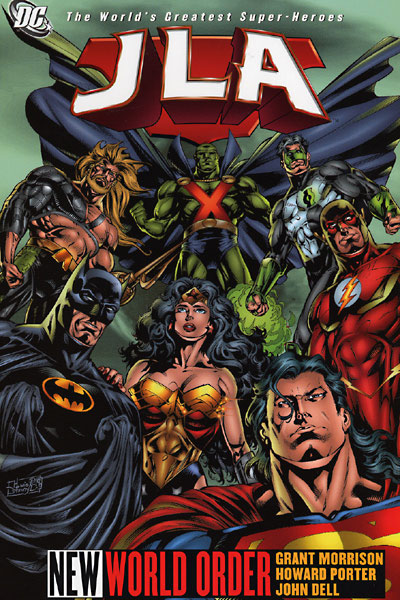Saturday, 19 May 2012
Review: Grant Morrison's J.L.A: New World Order
JLA #1-4 By Morrison / Porter/ Dell
In a climate where the Justice League is one of the hottest titles around, boasting a superstar creative team and positioned at the centre of the D.C Universe, it is sometimes difficult to imagine a time when it was languishing in terms of both popularity and acclaim. In the early to mid 1990's though, that was very much the case. The team was split into several different incarnations, including Justice League: International, Justice League: Europe and the very 90's sounding Extreme Justice. Although the tactic initially proved relatively popular with Keith Giffen and J.M DeMatteis earning plaudits for their initial run on Justice League: International, after their departure the titles steadily waned, until Grant Morrison and John Dell were brought in to restore what should be a flagship title for D.C to the level of popularity that it deserves.
World Order sees the 'Big Seven' - Superman, Batman, Wonder Woman, The Flash, Green Lantern, Aquaman and Martian Manhunter - together again for the first time since the mid 1980's, reunited to stop a mysterious cabal of aliens from taking over the world. The plot has its fair share of twists and turns, but at its heart it is as conventional as it sounds, and four issue running length aside would not have been out of place in the Silver Age. This is a portrayal of the team tailored to the mainstream, with the likes of Green Lantern and Aquaman pushed to one side to allow starring roles for Batman and Superman - although Martian Manhunter is refreshingly granted some time in the spotlight. That is not necessarily a bad thing of course, and as an introduction to the team this arc works well enough. There is little characterisation, but the various members of the team are fleshed out enough to ensure that they are not simply ciphers. There is little depth to be found in most of them yet, but that allows the focus to be placed squarely on Morrison's larger than life plot.
This is a fairly progressive take on the tired 'Aliens invade' plot template, although it is hardly the sort of high concept stuff that Morrison has become so famed for. The arc is paced in breakneck fashion, and although there are some very interesting ideas on show they are never really given much space to breathe. The action though, never lets up, and this is a story in the classic comic book tradition from the first page onwards. The heroes are larger than life and the villains are dastardly wretches, although there hints at modernisation - the civillians of the story have a larger role to play than the mindless fodder than they are often characterised as, although it only becomes apparent nearer to the story's end.
In modern day terms, this is a story that feels a little bit dated. The appeal of seeing the big seven together again has worn off, and there is little about the dialogue or characterisation to drag a bog standard plot up from mediocrity. Howard Porter's pencils are solid, and suit the story to a teen, but feel steeped in the sort of the 90's iconography that is viewed with suspicion today. This is a fun enough superhero story, but I expected more from the radical comic book storyteller that Grant Morrison has proved himself to be.
C
Subscribe to:
Post Comments (Atom)


It's interesting to revisit the initial JLA arc from this kind of perspective. In many ways, this is the exact reaction that Morrison's Final Crisis got, which was basically his return to the team, and very much in the vein of what he did with it previously. This was the birth of "widescreen comics," meaning that splash pages became exponentially more important to the storytelling, which still defines how DC does things today. The story is done is fairly broad strokes to emphasize both the scope of the threat and the ability of the League to handle it, both in the approach, how things seem to totter out of control, and how everything is resolved through the sheer awesome ability of the team in this iconic combination. This is where Batman truly rose to the level of virtual superhuman ability, with Morrison postulating his mental abilities far exceeding normal levels and thus being able to compensate for his lack of powers, so that even the Frank Miller version in The Dark Knight Returns is no longer relevant. It's the way Morrison has written the character ever since, and several writers since then as well, including Geoff Johns.
ReplyDeleteInteresting analysis. As someone who has read very little Justice League it is difficult for me to place Morrison's run into the wider context of their history. For what it's worth I enjoyed the issue that followed this arc a lot more.
ReplyDelete